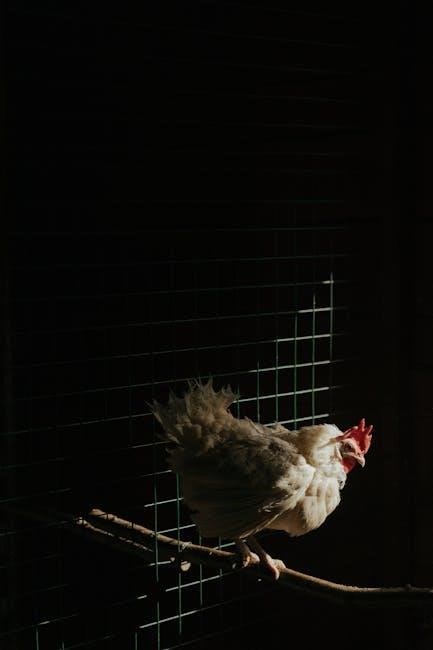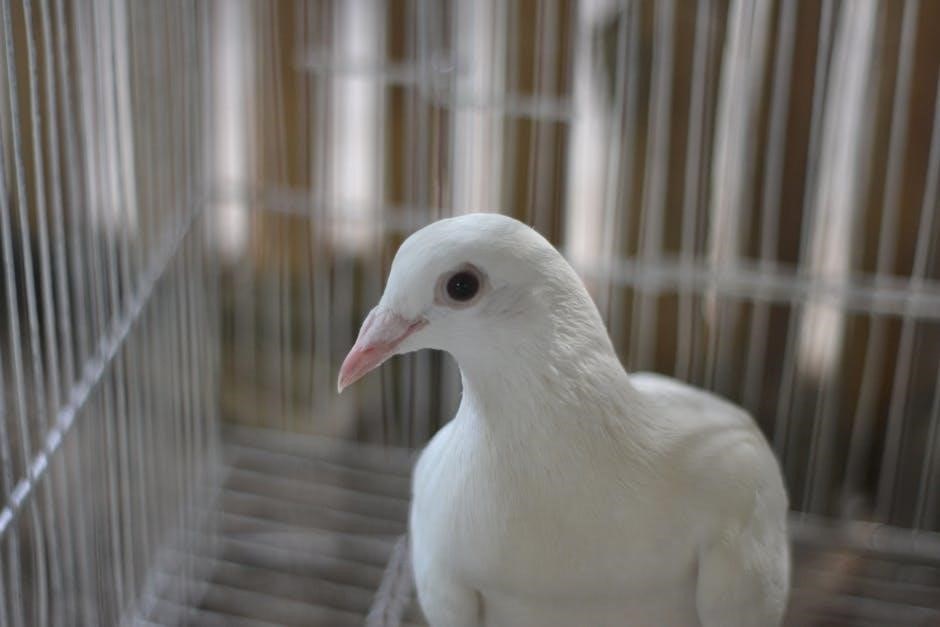Maya Angelou’s poem, “I Know Why the Caged Bird Sings”, is a powerful metaphor exploring oppression, freedom, and identity, deeply rooted in her autobiographical experiences and the African-American struggle.
Background of the Poem
The poem “I Know Why the Caged Bird Sings” is part of Maya Angelou’s autobiographical work, first published in 1969. It draws inspiration from her childhood experiences and the broader context of racial inequality in America. The poem was influenced by earlier works, such as Paul Laurence Dunbar’s poem “Sympathy”, which also explores the theme of confinement. Angelou’s piece reflects her journey through racism, personal trauma, and the pursuit of freedom. The poem’s structure and imagery were crafted to evoke emotions, with the caged bird symbolizing oppression and the free bird representing liberation. Its release coincided with the Civil Rights Movement, resonating deeply with the era’s struggles for equality and justice.
Significance of the Title
The title “I Know Why the Caged Bird Sings” holds profound meaning, symbolizing the struggle for freedom and the resilience of the human spirit. The caged bird represents oppression and confinement, while its song signifies hope and longing for liberation. This duality reflects Maya Angelou’s personal experiences with racism and her journey toward self-discovery. The title, inspired by Paul Laurence Dunbar’s poem “Sympathy”, captures the essence of the African-American experience during the Civil Rights era. It has become an iconic symbol in literature, embodying the universal quest for freedom and equality, and continues to resonate with readers today, making it a cornerstone of modern poetry and social commentary.
Maya Angelou’s Autobiographical Influence
Maya Angelou’s personal experiences deeply shaped “I Know Why the Caged Bird Sings”, drawing from her childhood in the segregated South. Her journey through racism, identity, and resilience is reflected in the poem’s themes. Angelou’s autobiography, which this poem is part of, offers a raw portrayal of her early life, including her time in Stamps, Arkansas, and her relationship with her brother Bailey. These autobiographical elements infuse the poem with authenticity, making it a powerful expression of her lived experiences. By weaving her personal story into the narrative, Angelou creates a universal message of hope and defiance, resonating with readers worldwide and cementing her legacy as a trailblazing writer.

Historical Context of the Poem

The poem is set against the backdrop of the Civil Rights Movement and early 20th-century racial injustice, reflecting the era’s tensions and the struggle for equality.
The Civil Rights Movement and Its Impact
The poem reflects the Civil Rights Movement’s era, where African-Americans sought equality and justice. It captures the struggle against racial segregation and discrimination, resonating deeply with the movement’s goals. The imagery of the caged bird symbolizes the oppression faced by many, while the free bird embodies the hope for freedom and equality. Angelou’s work became a powerful voice for the movement, inspiring others to join the fight against injustice. The poem’s themes of resilience and hope align with the movement’s spirit, making it a timeless representation of the struggle for civil rights and social change.
Racial Injustice in the Early 20th Century
The poem reflects the pervasive racial injustice of the early 20th century, particularly in the segregated South. African-Americans faced systemic discrimination, violence, and disenfranchisement, which shaped the caged bird’s metaphor of oppression. The poem captures the emotional toll of living under such conditions, where freedom and equality were distant dreams. Angelou’s vivid imagery conveys the stifling reality of racial inequality, resonating with the collective experience of Black Americans during this period. The caged bird’s longing for liberation mirrors the broader struggle for justice and human dignity, making the poem a poignant commentary on the era’s racial injustices.
Maya Angelou’s Personal Experiences
Maya Angelou’s personal experiences deeply influenced her poem, drawing from her childhood in the segregated South. She faced racism, trauma, and personal struggles, which are mirrored in the caged bird’s plight. Her early life, marked by displacement and marginalization, shaped the poem’s themes of oppression and resilience. Angelou’s autobiography, I Know Why the Caged Bird Sings, intertwines with the poem, reflecting her journey toward self-discovery and liberation. The poem becomes a testament to her enduring spirit, transforming personal pain into a universal symbol of hope and resistance. Her voice gives expression to the silenced, making her story a powerful collective narrative.
Literary Style and Structure
Maya Angelou’s poem uses vivid imagery and a simple yet evocative structure to contrast the caged and free birds, symbolizing oppression and liberation through their differing songs and flights.
Use of Imagery and Symbolism
Maya Angelou’s poem masterfully employs imagery and symbolism to convey its themes. The caged bird, a powerful symbol of oppression, contrasts sharply with the free bird, embodying liberty and aspirations. Angelou uses vivid descriptions of the caged bird’s fearful trill and the free bird’s soaring to highlight the disparity between confinement and freedom. The sky serves as a symbol of limitless possibility, while the cage represents systemic barriers. These images evoke strong emotions, drawing readers into the struggle for liberation. The poem’s rich symbolism transforms ordinary elements into profound metaphors, allowing readers to connect deeply with the universal themes of freedom and resilience.
The Role of Metaphor in the Poem
Metaphor plays a central role in “I Know Why the Caged Bird Sings,” with the caged and free birds serving as potent metaphors for oppression and liberation. The caged bird symbolizes the stifled voices of marginalized communities, while the free bird represents aspirations and freedom. Through these metaphors, Angelou conveys the emotional and psychological impact of racial injustice. The contrast between the birds’ experiences highlights the struggle for equality, making the poem a powerful allegory for the African-American experience. The metaphors resonate universally, inviting readers to reflect on their own struggles and hopes, thereby amplifying the poem’s emotional and social impact.
Structure and Rhythm in the Poem
The poem’s structure and rhythm are carefully crafted to reflect the emotional depth of its themes. Angelou uses short, fragmented sentences to convey tension and oppression, while longer, flowing lines evoke a sense of longing and hope. The rhythm mirrors the contrast between the caged bird’s hesitant trills and the free bird’s soaring melodies. This structural choice emphasizes the struggle for liberation and the resilience of the human spirit. The poem’s cadence also adds a musical quality, making it accessible and impactful. Through its deliberate pacing, Angelou masterfully guides the reader through a journey of pain and ultimately, hope, reinforcing the poem’s universal appeal.
Themes of the Poem
The poem explores themes of oppression, freedom, identity, and resilience, capturing the emotional depth of the African-American experience and the universal struggle for liberation and hope.
Oppression and Freedom
The poem vividly contrasts the lives of two birds: one caged, symbolizing oppression, and one free, embodying liberation. The caged bird’s fearful trills reflect the stifling effects of racial and societal constraints, while the free bird’s soaring symbolizes the longing for freedom and equality. Through this powerful metaphor, Maya Angelou highlights the African-American experience, emphasizing the struggle against systemic oppression and the enduring hope for liberation. The poem serves as a poignant reminder of the historical and ongoing fight for freedom and the resilience of the human spirit in the face of adversity. Its themes resonate deeply, transcending time and context to inspire generations.
Identity and Self-Discovery
Maya Angelou’s poem delves into themes of identity and self-discovery, reflecting her own journey of finding voice and purpose amidst adversity. The caged bird’s struggle mirrors the internal conflict of self-definition, while the free bird represents the aspiration for unencumbered identity. Through vivid imagery, Angelou explores the tension between imposed societal roles and personal authenticity. The poem becomes a testament to the resilience of the African-American spirit, where self-discovery is not just individual but collective. By juxtaposing confinement and liberation, Angelou underscores the universal quest for identity, making the poem a powerful exploration of personal and cultural transformation.
Hope and Resilience
Maya Angelou’s poem embodies hope and resilience, as the caged bird’s song becomes a testament to enduring spirit despite oppression. The bird’s fearful yet persistent trill symbolizes the hope for freedom and a better future. Angelou’s work reflects her own journey of overcoming adversity, offering a message of resilience to marginalized communities. The poem suggests that even in confinement, the voice of hope persists, inspiring others to strive for liberation. This theme resonates deeply, showing how hope can transform suffering into strength and perseverance. The caged bird’s song is not just a cry of despair but a powerful affirmation of the human spirit’s capacity to endure and rise.
Symbols in the Poem
The poem uses vivid symbols like the caged bird, representing oppression, and the free bird, symbolizing freedom and aspiration, to convey deep emotional and social struggles.
The Caged Bird as a Symbol of Oppression
The caged bird in Maya Angelou’s poem symbolizes oppression, confinement, and the stifling of freedom. Its presence reflects the constraints faced by marginalized communities, particularly African-Americans, under systemic racism and societal limitations. The bird’s inability to fly or sing freely mirrors the oppression experienced by individuals whose voices are silenced or whose potential is suppressed. Through this powerful imagery, Angelou conveys the emotional and psychological toll of being trapped, both literally and metaphorically, resonating deeply with the struggles of those seeking liberation and equality. The caged bird’s fearful trill underscores the longing for freedom and the resilience of the human spirit.
The Free Bird as a Symbol of Freedom
The free bird in Maya Angelou’s poem embodies freedom, liberation, and the unbridled joy of self-expression. It sings with abandon, its voice echoing the hopes and aspirations of those yearning to break free from oppression. The free bird’s ability to soar and explore the vast sky symbolizes the limitless possibilities available to those who are unencumbered by societal or systemic constraints. Its song is a celebration of autonomy and the human spirit’s innate desire for liberty. In contrast to the caged bird, the free bird represents the ideal of freedom, inspiring those trapped to envision and strive for a life beyond their confines. Its presence underscores the universal longing for liberation and equality.
The Sky as a Symbol of Aspiration
The sky in Maya Angelou’s poem serves as a profound symbol of aspiration, representing boundless hope and the infinite possibilities that lie beyond the confines of oppression. It embodies the dreams and desires of the caged bird, who longs to soar freely, unshackled by the chains of captivity. The sky’s vastness and beauty inspire the bird to envision a life where it can sing without fear, its voice echoing through the expanse. This imagery underscores the universal human aspiration for freedom, equality, and transcendence, making the sky a powerful and enduring motif in the poem’s exploration of liberation and self-discovery. Its presence elevates the narrative to a realm of timeless inspiration.

Reception and Impact
Maya Angelou’s “I Know Why the Caged Bird Sings” received widespread acclaim for its raw honesty and cultural significance, becoming a landmark in African-American literature and inspiring countless adaptations.
Initial Reception of the Poem
The poem “I Know Why the Caged Bird Sings” was initially met with critical acclaim upon its release in 1969. Reviewers praised Maya Angelou’s raw honesty and emotional depth, calling it a groundbreaking work in African-American literature. The vivid imagery and powerful metaphors resonated deeply with readers, making it an instant classic. However, its frank discussion of race and personal trauma also sparked controversy, leading to challenges in schools and libraries. Despite this, the poem’s impact endured, solidifying Angelou’s reputation as a leading voice in American poetry and civil rights advocacy.
Controversy Surrounding the Poem
Maya Angelou’s “I Know Why the Caged Bird Sings” faced significant controversy due to its unflinching portrayal of racism, sexual assault, and personal trauma. Critics argued that the explicit content was inappropriate for young readers, leading to bans in several schools and libraries. Despite this backlash, the poem’s honest narrative resonated with many, particularly within the African-American community, who saw it as a courageous reflection of their shared struggles. The controversy, however, only heightened its prominence, cementing its place as a pivotal work in the discussion of race, identity, and resilience in American literature.
Legacy of the Poem
Maya Angelou’s “I Know Why the Caged Bird Sings” has left an indelible mark on literature and culture. Its raw honesty and powerful imagery have inspired countless readers, making it a cornerstone of African-American literature. The poem’s exploration of oppression, resilience, and freedom continues to resonate globally, sparking conversations about social justice. It has been adapted into plays, albums, and educational curriculums, ensuring its message endures. Angelou’s work remains a testament to the transformative power of poetry, solidifying her legacy as a trailblazer in both literature and civil rights. Its enduring relevance ensures it will continue to inspire future generations.

Autobiographical Elements
Maya Angelou’s “I Know Why the Caged Bird Sings” deeply reflects her childhood experiences, blending personal struggles with racial and social challenges, mirroring her autobiography’s raw authenticity.
Maya Angelou’s Childhood Experiences
Maya Angelou’s childhood, marked by racial segregation and personal trauma, profoundly shaped her writing. Born in 1928, she faced early hardships, including her parents’ separation and a period of muteness after a traumatic event. Her experiences in the segregated South influenced her portrayal of oppression in “I Know Why the Caged Bird Sings”. The poem mirrors her journey of resilience, capturing the emotional depth of her formative years. These early struggles became the foundation of her literary voice, blending personal narrative with universal themes of identity and freedom.
Racism and Trauma in Her Life
Maya Angelou’s life was deeply impacted by racism and trauma, which are central themes in her work. Growing up in the segregated South, she endured racial discrimination and personal abuse, including a traumatic childhood rape. These experiences left lasting emotional scars, yet they also fueled her writing. In “I Know Why the Caged Bird Sings”, she poignantly captures the pain of oppression and the resilience required to overcome it. Her ability to transform personal trauma into powerful poetry has made her a voice for marginalized communities, offering hope and solidarity through her words.
The Influence of Her Autobiography
Maya Angelou’s autobiography profoundly shaped her poetry, particularly in “I Know Why the Caged Bird Sings”. Drawing from her personal journey, she wove themes of race, identity, and resilience into her work. The autobiography’s raw honesty and emotional depth provided a foundation for her poetic voice, allowing her to connect deeply with readers. By sharing her struggles and triumphs, Angelou created a literary legacy that continues to inspire. Her work bridges personal narrative with universal themes, making her one of the most influential voices in African-American literature and beyond. Her autobiography’s impact remains a testament to the power of storytelling.

Comparative Analysis
The poem contrasts the caged bird’s silenced sorrow with the free bird’s joyful song, symbolizing oppression and liberation, while highlighting the universal struggle for freedom and voice.
Comparison of the Caged and Free Birds
The poem vividly contrasts the caged bird, symbolizing oppression, with the free bird, representing liberation. The caged bird sings with a “fearful trill,” longing for freedom, while the free bird soars, singing of vast skies and unshackled joy. This comparison underscores the deep emotional and physical divide between confinement and liberation, reflecting the African-American experience. The caged bird’s restricted song mirrors silenced voices, while the free bird’s melody embodies hope and resilience. This duality highlights the universal struggle for freedom and equality, making the poem a powerful allegory for social justice and the human spirit’s enduring quest for liberation and expression.
Contrast Between Oppression and Freedom
The poem starkly contrasts oppression and freedom through the imagery of the caged and free birds. The caged bird, representing oppression, sings with a “fearful trill,” its voice muffled by confinement, reflecting the suffocation of marginalized communities. In contrast, the free bird soars effortlessly, its song a joyful celebration of liberation. This vivid dichotomy underscores the emotional and physical toll of oppression while highlighting the universal human longing for freedom. The free bird’s unbridled song symbolizes the triumph of the spirit, offering hope and resilience. This contrast serves as a poignant reminder of the ongoing struggle for equality and the enduring quest for liberation. The imagery is both haunting and uplifting, encapsulating the African-American experience.
The Role of Sound and Silence
The poem employs sound and silence to convey the emotional depth of oppression and freedom. The caged bird’s “fearful trill” contrasts with the free bird’s melodious song, symbolizing the stifling of voice under oppression. The caged bird’s restricted song reflects the silencing of marginalized communities, while the free bird’s distant tune embodies the longing for liberation. Silence, in this context, amplifies the caged bird’s despair, whereas sound becomes a powerful tool for expression and defiance. This interplay of sound and silence highlights the emotional struggle and resilience of those yearning for freedom, making it a poignant commentary on the human condition.
Cultural Significance
Maya Angelou’s poem holds profound cultural significance, resonating deeply within African-American literature and inspiring social justice movements, while its universal themes continue to influence modern interpretations globally.
The Poem’s Role in African-American Literature
Maya Angelou’s poem, “I Know Why the Caged Bird Sings”, is a cornerstone of African-American literature, reflecting the struggles and aspirations of the Black community. Its vivid imagery and powerful metaphors resonate deeply, capturing the essence of racial oppression and the longing for freedom. The poem not only highlights the African-American experience but also inspires solidarity and hope. Its influence extends beyond literature, shaping social justice movements and inspiring future generations of writers. By blending personal and collective struggles, Angelou’s work has become a defining voice in the literary canon, cementing its legacy as a pivotal piece in African-American cultural expression.
Its Influence on Social Justice Movements
Maya Angelou’s “I Know Why the Caged Bird Sings” has profoundly influenced social justice movements, becoming an anthem for marginalized communities. Its powerful exploration of oppression and freedom resonates with activists fighting systemic racism and inequality. The poem’s themes of resilience and hope have inspired movements like Black Lives Matter and feminist activism, serving as a rallying cry for justice. Angelou’s work continues to motivate individuals to challenge societal norms and strive for equality, making it a cornerstone of modern activism and a testament to the enduring power of literature to drive social change and empower communities worldwide.
Modern Interpretations of the Poem
Modern interpretations of “I Know Why the Caged Bird Sings” highlight its timeless relevance in contemporary culture. The poem has been reimagined through various art forms, such as hip-hop and theater, to resonate with new generations. Its themes of oppression and freedom are now applied to issues like racial justice and gender equality. Many artists and activists draw inspiration from Angelou’s work, blending her poetry with modern beats and visuals. This fusion keeps the poem alive, ensuring its message of hope and resilience continues to inspire global audiences. Its adaptability underscores the enduring power of Angelou’s words in addressing modern societal challenges and aspirations.
“I Know Why the Caged Bird Sings” remains a powerful metaphor for freedom and resilience, inspiring generations with its timeless message of hope and the pursuit of equality.
The poem “I Know Why the Caged Bird Sings” delves into themes of oppression and freedom, using the caged and free birds as metaphors for societal constraints and liberation. It explores identity and self-discovery, reflecting Maya Angelou’s personal journey and the broader African-American experience. The poem also emphasizes hope and resilience, as the caged bird’s song symbolizes the enduring spirit of those seeking freedom. These themes resonate universally, making the poem a cornerstone of African-American literature and a powerful tool for social justice movements. Its imagery and symbolism continue to inspire modern interpretations and reflections on human rights.
Final Thoughts on the Poem’s Impact
“I Know Why the Caged Bird Sings” remains a profound and timeless piece, inspiring countless readers with its vivid imagery and emotional depth. Its exploration of racial injustice and personal resilience has left an indelible mark on literature. The poem’s ability to transcend generations and cultures underscores its universal relevance. Maya Angelou’s work continues to empower individuals, fostering a deeper understanding of the struggle for equality. Its influence extends beyond literature, shaping social justice movements and cementing its legacy as a powerful voice for freedom and hope. The poem’s enduring impact is a testament to Angelou’s genius and her unwavering commitment to justice.
